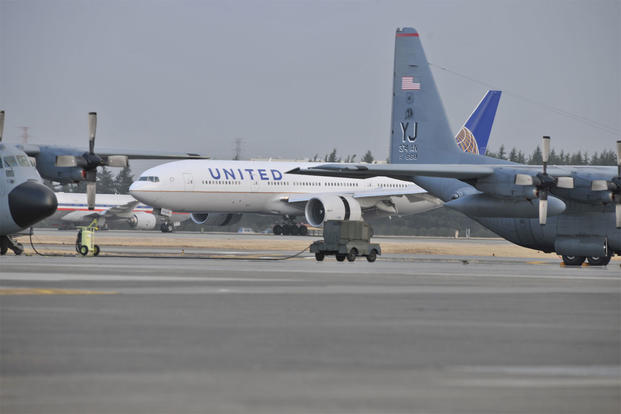U.S. military officials next month will meet with their counterparts in the airline industry to discuss how the Pentagon and commercial airlines can work together to deal with a nationwide pilot shortage, the head of Air Mobility Command said Wednesday.
The meeting is set to take place May 18 at Joint Base Andrews in Maryland, Gen. Carlton Everhart II said during a breakfast with defense reporters Wednesday in Washington, D.C.
"We have competing resources," he said, referring to the military and the airline industry. "So how do we complement each other instead of competing against each other? And that is one of the objectives of this meeting."
The head of Air Mobility Command said he stands to potentially lose 1,600 pilots who are eligible to separate from the service in the next four years. The command, which provides airlift and transport services, is among the first place civilian airlines look for potential hires.
Everhart said he plans to attend the meeting -- which is actually the third such get-together involving military and airline officials -- along with Air Force Chief of Staff Gen. David Goldfein, headquarters Air Force and operations personnel, airline industry representatives and regional airline officials, as well as colleagues from the Army, Marine Corps and the Navy.
Academic institutions such as Embry Riddle University, an aeronautical university specializing in aviation and aerospace, and civil reserve airfleet institutions such as FedEx or UPS may also attend, Everhart said. RAND Corp., a nonprofit institution that provides research and analysis studies on public policy, will also sit in for research purposes, he said.
One concern Everhart hears repeatedly is the "1,500 rule," he said, referring to the number of hours the Federal Aviation Administration requires civilian pilots to have before they can fly for a major airline.
"The 1,500 rule -- where did that 1,500 hours come from?" Everhart said. "That came out of some aircraft incidents that happened."
A military-trained pilot needs only 750 hours under FAA rules, "which makes us a highly valuable commodity to the airline industry," he said.
But it's not just pilots.
Demand is also surging for aircraft maintainers and air traffic control room operators as well because they, too, are sought after by the airlines, Everhart told reporters and congressional staffers Friday at Joint Base Andrews in Maryland.
Everhart said he wants industry to lead the meeting "with solutions" for these dilemmas but he also has a few ideas in mind.
To get around the 1,500-hour threshold for the airlines, Everhart suggested a compromise. What if the airline industry creates pilot training simulation complexes around the country for incoming or potential recruits to train in a simulator to gain "valuable experience?" It may get people to stay in aviation and grow the selection pool, he said.
Debt forgiveness from four-year undergraduate schools may be another way to get pilots, he said.
Or "maybe I can have pilots who come on active-duty take a sabbatical like we're doing with some of the family members right now," he said. "They go on sabbatical for five years and work for the airline industry ... and then come back to me. Or they go to the Guard or Reserve because they're hurting also," Everhart said.
In that case, the pilot is being used by both the military and the civilian world without having to choose a long-term career path.
Throwing more money -- in pilot bonuses and pay -- will never be the only solution, said Everhart, who is currently conducting exit surveys of outgoing pilots.
The fiscal 2017 National Defense Authorization Act authorizes the Air Force to increase aviation retention pay from $25,000 to $35,000 per year and flight pay up to $1,000 per month "as needed to address manning shortfalls and challenges," according to the service.
Everhart said, "Most people serve because it's what's in their heart. The bonus was very nice. [But] the bonus is not why I stayed in." He has flown aircraft such as the C-130E/H, C-17A, C-21A, C-9A, C-5A, KC-135R, among others, according to his official biography.
A better way to find solutions, Everhart said, is to ask the right questions going forward -- turning from, "Why did a pilot leave?" to "Why did he stay?"
"Because once you figure that one out, you can go and assess those people and then bring them on so they stay, and the chances of them staying is in your favor," he said.
-- Oriana Pawlyk can be reached at oriana.pawlyk@military.com. Follow her on Twitter at @Oriana0214.





























